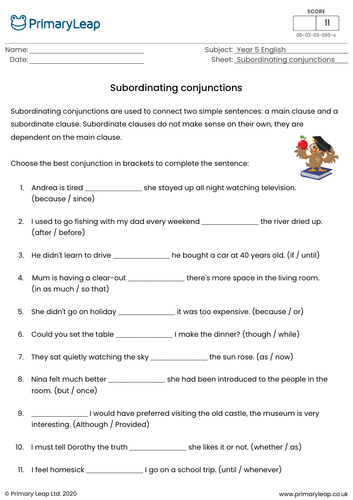560Uploads
454k+Views
210k+Downloads
English language arts

Circle the Contractions - English Resource
A contraction is a word made by shortening and combining two words. Words like can’t (can + not) and don’t (do + not) are contractions. Students read each sentence and circle the contraction in each sentence.

English Worksheet: Adjectives with Suffix - ful
This year 3 English resource is designed to encourage children to use adjectives with suffix - ful. Students write their own sentences using the words provided.
Additional worksheets, lesson plans, and interactive activities are available on Primary Leap.

English Worksheet: Adjectives with Suffix - less
This year 3 English resource is designed to encourage children to use adjectives with suffix - less. Students write their own sentences using the words provided.

Research Activity - All Saints' Day
All Saints’ Day, also known as All Hallows, is celebrated on 1st November by the Catholic Church, in honour of all the saints, known and unknown. Students are asked to choose one of the four patron saints mentioned in the worksheet and find out some important information about them. They are asked to include when their special day is, if they have a symbol and why people remember that day.

Spelling Worksheet - Halloween Theme
This Halloween worksheet includes 12 spellings for students to learn. Students put the spellings in alphabetical order and fill in the missing words to complete the sentences about Halloween.

Making Inferences from Pictures - Halloween Resource
Students are asked to write 5 inferences they can make about the picture.
Additional worksheets, lesson plans, and interactive activities are available on Primary Leap.

Match the Contractions - English Resource
A contraction is a word made by shortening and combining two words. Words like can’t (can + not) and don’t (do + not) are contractions. Students draw a line to match the contractions.
Additional worksheets, lesson plans, and interactive activities are available on Primary Leap.

Writing Contractions - English Resource
A contraction is a word made by shortening and combining two words. Words like can’t (can + not) and don’t (do + not) are contractions. Students write the two words that each contraction stands for. They then write the contraction for each set of words.

Find the Halloween Noun
Students are asked to find the Halloween noun in each of these spooky sentences and underline it.
Additional worksheets, lesson plans, and interactive activities are available on Primary Leap.

Christmas Picture Crossword
This worksheet was created by Primary Leap
Add some festive fun to your lessons with this colourful Christmas picture crossword. Students look at the pictures and complete the crossword puzzle.

English worksheet: Match the contractions (won't, couldn't, haven't etc.)
This resource was created by Primary Leap
A contraction is a word made by shortening and combining two words. Students are asked to draw a line to match the contractions.
These resources can be used for home learning or in the classroom. I hope you find them useful.

Christmas Mad Libs
Created by Primary Leap
This Christmas themed resource can be used to reinforce language arts lessons learned in class. Students fill in the blanks with a type of word e.g. an adjective or a noun. Encourage your students to be as creative as possible and have some fun!

KS2 English - Possessive apostrophe
Apostrophes can be used to show that something belongs to something or someone else. Example: The bear’s paws were big. This English resource asks students to underline the possessive noun in each sentence.
Created by Lauren Savage

KS2 Creative writing activity: Back To School - What If...?
A fun creative writing worksheet to get kids thinking! Students imagine it is the first day of school and answer the ‘what if’ questions.
This creative writing resource was created by Lauren Savage

KS2 English resource - Use of the hyphen
This KS2 English resource was created by Primary Leap
The symbol (-) is called a hyphen in the English language. A hyphen is a short horizontal line used to link words together. Students read through sentences and write the word that is missing a hyphen.

Active or passive?
An active voice is when the subject of the sentence is performing the act. A passive voice is when the subject of the sentence is having something done to it by somebody else. Often the word ‘by’ is used, but not always. This English worksheet asks students to write ‘active’ or ‘passive’ after each sentence.
This worksheet was created by Lauren Savage

Verb prefixes - dis and mis
A prefix is a group of letters added before a word to alter its meaning. The prefix ‘dis’ is generally used to make a word negative. The prefix ‘mis’ means badly, wrongly or incorrectly. This English resource asks students to choose the correct word to complete the sentence.
This worksheet was created by Lauren Savage

Relative clauses
Relative clauses are used to connect sentences. We use relative clauses to give additional information about something without starting a new sentence. The most common relative pronouns are: who, whom, whose, which and that. This English resource asks students to choose the best relative pronoun to complete the sentences.
This worksheet was created by Lauren Savage

KS2 English - Subordinating conjunctions
Subordinating conjunctions are used to connect two simple sentences: a main clause and a subordinate clause. Subordinate clauses do not make sense on their own, they are dependent on the main clause. This English activity asks students to choose the best conjunction in brackets to complete the sentences.
Resource created by Lauren Savage

Verb prefixes - de and re
A prefix is a group of letters added before a word to alter its meaning. The prefix ‘de’ is used to reverse the verb’s actions. It can also mean ‘down’ such as in the words decrease or decline. The prefix ‘re’ means to do again. This English resource asks students to choose the correct word to complete the sentence.
This worksheet was created by Lauren Savage




















